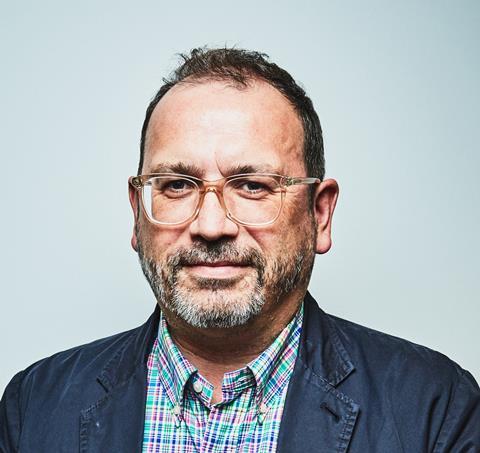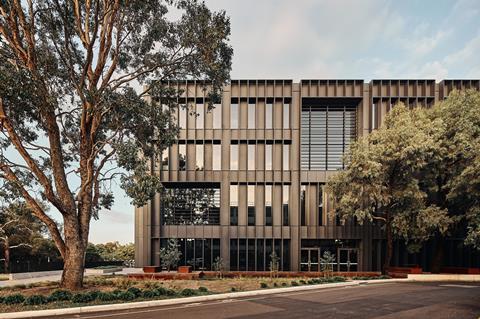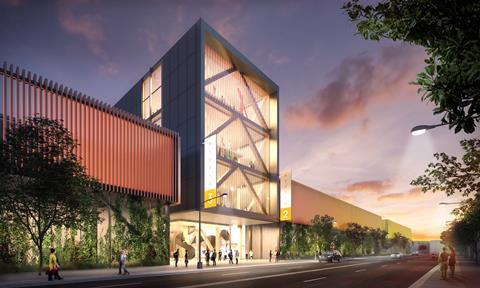Mark Middleton, global managing partner, talks about the practice’s vision, different ways of working and his new three-year business strategy
The global economy is facing almost unprecedented challenges and yet, amid the gloom, British architects appear to be weathering the storm surprisingly well. One practice that is looking ahead with confidence is Grimshaw.
Having grown far beyond its founder’s original vision, Grimshaw has become a large international consultancy. But size brings with it huge pressure to sustain a pipeline of work and provide opportunities for staff to progress internally.
With the UK teetering on the edge of recession, there are strong headwinds confronting the business. In this interview Mark Middleton, global managing partner, talks about his long career at Grimshaw, the practice’s journey to becoming a global player, and its vision for a growth-driven and diverse future.
A career built at Grimshaw

After six years as London managing partner, Middleton took over as global managing partner in 2020. He is now two years into his three-year term.
He suggests meeting for the interview at the practice’s Clerkenwell office. Although he is based in Sydney, he is on a flying visit to London, where he is due to present his fellow partners with a three-year strategy document for Grimshaw’s global business.
Middleton has been with the practice for 26 years. When he joined there were only 30 staff. Having previously worked for the British Rail architects’ department and on the Jubilee Line Extension, his focus has been on developing Grimshaw’s position within transport.
“I was told fairly early on at Grimshaw that I needed to start bringing in clients,” he says. “So I just started asking my engineering contacts from my time at British Rail.”
Through a friend at WSP, Middleton got wind of the London Bridge station project. “They had a reference design, which everyone knew was not good enough. So we quoted a competitive fee to win the job and then worked from there.”
Transport is now the “red thread that runs through every studio”, according to Middleton.
The London office is heavily involved in HS2, with Euston station and other elements of the line likely to keep the practice busy for the next decade or so. “The big question for us in London is what comes next,” he says.
From small design practice to global player
With the storm clouds of recession hanging over the UK, Middleton is keenly aware of the benefits of having a global presence. But being a global practice is not an end in itself.
“We want to be in a place – we want to know it,” says Middleton. “It’s about people being based there.” This is one reason that Middleton has swapped London for Sydney, from where he currently overseas Grimshaw’s global operations and rapid expansion in Australia.
Middleton is about to present the three-year strategic plan to the other partners for approval and then share it with its senior leaders globally. Two of the key drivers are sustainable growth and diversity. As Middleton points out, the two issues are closely connected.
For him, growth is all about providing career paths and opportunity for those already within the practice. And the new strategy is about how to deliver growth and where to focus investment.
We kept Nicholas Grimshaw’s values and ethos, packed them in a suitcase and took them around the world
Middleton openly acknowledges that the Grimshaw global model is far removed from its founder’s vision. “This isn’t Nick’s vision. Nick always wanted to keep it small,” he says. “But we kept Nick’s values and ethos, packed them in a suitcase and took them around the world.”
He describes the early days of the global expansion as “naïve adventuring”, with current chairman Andrew Whalley playing a key role in embracing the risk-taking required to seek out new opportunities internationally.
A diversified global model

“The beachhead has always been shaping cities through infrastructure,” says Middleton. Over time Grimshaw has developed a model where it works closely with engineers, going in on bids together. He again traces this back to his time working for British Rail’s in-house design team.
But each office has evolved slightly differently. In the UK, where transport makes up almost 50% of the workload, Middleton says that “transport unlocks cities and communities, but we are working across the full range of sectors that make those places thrive, grow, be resilient.”
In Los Angeles the practice is working on a lot of residential and industrial projects, often using mass timber construction. In Australia there is a focus on metro rail, high-rise office space and higher education, such as the recently completed Woodside Building for Monash University in Melbourne.
Global Grimshaw
Grimshaw was founded in 1980 by Nicholas Grimshaw, who had previously worked with Terry Farrell on projects such as the innovative 125 Park Road in London and Herman Miller factory in Bath. Since then, the practice has grown into one of the UK’s leading global architectural players.
Best known for transportation, but with expertise and a strong track record across most sectors, the practice focuses on large complex projects with a significant urban impact.
Grimshaw is an LLP with 21 partners and more than 600 staff globally. The structure of the design practice is built around what it calls its four “home studios” in London, New York, Sydney and Melbourne, where most of its partners are based, plus a slightly smaller Los Angeles studio, with one partner.
It also currently has satellite studios in Paris and Dubai, which are supported by partners remotely but which it is hoping to grow over the next few years. A new satellite is due to open shortly in Auckland, and there are also smaller project offices in Hong Kong and Shenzhen.
Middleton says the practice has learnt from experience that there are risks when studios have slightly ignored their home markets. Prior to covid the US business had become too heavily dependent on delivering projects in the Middle East.
When the pandemic struck, work dried up. And without a UK-style furlough scheme, the US business was forced to contract by more than half.
The focus is now on encouraging each of the home studios to embed themselves in their regional economies. It was a hard lesson to learn, but the US practice is already back up to 100 and focusing on the domestic market, which remains buoyant.
In the future every home office will be aiming for 70% of revenue to come from its region and around 30% from elsewhere.
The 2025 strategy is also aimed at helping to grow the smaller satellite studios into larger operations to match the existing larger home studios. LA, Dubai, Paris and Auckland are all identified for growth.
Middleton points to the LA office as one that is already moving in the right direction. Partner Andrew Byrne moved there from London in 2017. The office recently won a project to design 16 sound stages for East End Studios.

It has helped diversify the business and embed the firm in the local economy. The LA office has been up and running for five years and is now nearly at 30 staff members.
Middleton wants the practice to grow by 20%-30% in the next two or three years. “It’s about optimising the offices we’ve got,” he says. The practice also recently won the project to redesign the central station in Budapest, part of what Middleton describes to a “pivot towards looking at Europe”.
Grimshaw has never had a time when its grey everywhere at the same time. It underlines the need to have a global business
Although he’s global managing partner, the company requires him to continue to manage projects. He’s currently overseeing a major overhaul of the historic Railway Hall of Sydney’s Central Station, and six new metro stations on Sydney’s new West Metro line.
He believes that maintaining that contact with the design and implementation of buildings is important to understanding the business and because the managing partner role is not permanent. At some point he will return full time to being a regular partner with full responsibility for a slate of projects.
Storm clouds may be gathering on the horizon but the types of large-scale transport infrastructure projects that form the basis of Grimshaw’s business model are long term, often lasting a decade or more. This helps the practice ride out economic cycles. So does the global spread.

Looking at the global situation he remarks that Grimshaw has “Never had a time when its grey everywhere at the same time. It underlines the need to have a global business.”
Currently the US is a major focus. Middleton says that revenue per full time equivalent employee is 50%-80% higher in the US than in the UK. “In the US it seems to be all systems go.”
The firm works its own data hard and has become highly strategic in choosing what to bid for and how much resources to put in. As Middleton notes, a firm can easily spend a lot of time and money on pitching for projects it is never going to win.
We try to avoid projects outside of the home regions that have no obvious social benefit or value
“Sometimes you just have to accept you’re not going to get the project. We look at where the bid is, whether we’ve won in that region before, and who we’re up against,” he says.
The practice spends around 10% of turnover bidding for new work – a figure that Middleton says he would like to get down to closer to 7.5%. As a general rule he says Grimshaw aims to spend no more than 1%-2% of the potential fee on a bid, as with tight margins any potential profit can rapidly be eroded.
There is also an ethical dimension to which projects the firm goes after. The practice has a cautious approach to some markets, while at the same time not believing in a blanket “we won’t work there” attitude. “We try to avoid projects outside of the home regions that have no obvious social benefit or value” he tells me.
Although Grimshaw has small offices in Hong Kong and Shenzhen and has launched its first foreign language website for China, there remains some hesitancy about committing more wholeheartedly to working in the economic superpower. Middleton puts this down to the relatively low fees the practice says it has encountered, and wider challenges relating to language and context. “But we are actively looking for great opportunities to work more productively in China”, he adds.

Taking an expansive approach
He acknowledges that it is tough for smaller practices starting out and welcomes the recent move towards bigger firms partnering up with smaller ones to win work. He also says that clients have been increasingly pushing for this. He points to Grimshaw working with Haptic on an airport in Noida and HS2 Euston as examples of where this has worked well.
Middleton is clearly keen to share. He says he is happy to pick up the phone to senior colleagues in other major firms and share his knowledge and insights. “The biggest problem with architecture is that unfortunately it’s a bit of a cauldron of jealousy for some,” he tells me. “I’m always happy to help people”.
He is now two years into his three-year spell as global managing partner and says he will “probably do another term. When I stop doing this, I will go back to being partner”.
Middleton tells me that the nature of the business is always changing. “The days of waiting for the work to fall into your lap are over,” he says. “The male-centric client drinking culture has gone, which was never the best way to conduct business.
“Clients are more diverse with many senior women. This is leading to a positive change for engagement, which needs to be around knowledge, research and adding value.” The practice’s proactive approach to identifying and bringing in work reflects this evolution.
If we want diversity we need to grow. It’s about how to grow sustainably without overstretching
He says in the past the practice would often only hear about big projects after they had been awarded to someone else. Now Grimshaw is constantly undertaking its own research, working in collaboration with other consultancies and using research undertaken by its in-house Cities Group. Run by Tim Williams in Australia, the Cities Group has helped Grimshaw win projects such as the Waterloo masterplan and a structure plan for a city in the Middle East.
He says he had no formal business training and learnt on the job. Asked whether Grimshaw has ever considered a chief operating officer model, he says: “Where people have tried it, I’m not sure it’s worked”.
Returning to the Grimshaw 2025 strategy, Middleton homes in again on the practice’s drive for more women in senior positions. “If we want diversity we need to grow. It’s about how to grow sustainably without overstretching.”
A dynamic workplace – diversity and different voices - are key to the new Grimshaw strategy. Middleton wants 30% of senior leaders to be women within three years, and 40% a further three years down the line. To achieve this, Grimshaw will need to grow from its current 600 staff to around 900.
“We are building a business around resilience and diversity”, Middleton says. With an impressive track record in a wide range of sectors, and an enviable global presence, Grimshaw looks well set to confront whatever trials lie ahead.
>>Also read: How are architects planning for a recession?
Postscript
Mark Middleton will be returning to BD as a regular columnist in early 2023
















2 Readers' comments